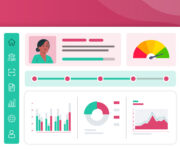In the last few years, the lending software industry has witnessed a surge in the number of startups aiming to bolster the credit ecosystem in India. This spurt mirrors a global trend, with international lending platforms seeking to capture increased market share.
Also, we have to note that the global digital market, estimated to be valued at 10.7 billion in 2021, is projected to grow to a market size of $ 20.5 billion in 2026.
In a highly-competitive space, lending startups seek ways to stand out from traditional players. They aim to bring instant credit and innovative products to consumers, especially underserved segments.
However, there are several contemporary challenges that lending startups face, including efficient risk management, evaluating creditworthiness on a large scale, customer acquisition, technology integration, etc.
In this blog post, let’s understand the challenges faced by lending startups and how leveraging the best lending software can help them build a competitive edge.
What Is The Best Lending Software?
This decade is going to be shaped by the increased adoption of emerging technologies such as Artificial Intelligence (AI) and Machine Learning (ML). Advanced AI-driven financial analysis software is helping lending businesses differentiate their offerings and deliver more value to borrowers.
This software essentially processes massive amounts of data related to a borrower’s financial history – from income statements and balance sheets to loan repayment activity – within minutes.
The best lending software also helps reduce the amount of time invested in the underwriting process. Powered by automation, Machine Learning (ML), and Artificial Intelligence (AI), it has the capabilities to bring a mix of speed, accuracy, and intuition to the creditworthiness analysis process.
Underwriters can access relevant data points in the creditworthiness reports to make their decisions to suit a borrower’s needs.
Lending Startups: Current Challenges
One of the most significant challenges is what comes after borrowers submit their loan applications. The pertinent question is, how do lending startups accurately assess a borrower’s creditworthiness and address their credit needs effectively?
Let’s look at some of the key challenges faced by lending startups:
1. Lack of Accuracy in Measuring Creditworthiness
Determining the creditworthiness of a company accurately is better managed when decisions are based on data. Focusing on the numbers helps weed out biases. However, a chunk of underwriting still happens through manual financial statement analysis.
2. Insufficient Fraud Detection
In the drive to process loan applications faster, lending startups are at risk of oversights that can result in loan fraud. Financial losses, loss of credibility, criminal proceedings, and growth of non-performing assets are some outcomes.
3. Lack of Inclusion
The traditional credit ecosystem has left out a large chunk of underserved customers, such as Micro, Small, and Medium-sized Enterprises (MSMEs). The issue is the lack of innovation in determining creditworthiness sans the use of a high credit score and credit history.
4. Customer Drop-offs
A manual approach to analysis and underwriting processes results in a slow turnaround time by lending startups. This status quo slows down the conversion rates as customers proceed to competitors who offer swifter services.
7 Key Benefits of Adopting the Best Lending Software
By leveraging AI-driven bank statement analysis software, lending businesses can address all these challenges and add more firepower to their underwriting operations.
Here is a snapshot of key advantages:
1. Process Automation
The entire process of analysing financial documents is automated. Hence, underwriters can get access to a detailed report and a system-generated credit score within a minute.
Such software can analyse documents present in over 700 formats and categorise transactions effectively. Automation helps free up the bandwidth of underwriters who can focus on tasks that require intellectual input.
2. Customisation of Dashboards
Lending teams can personalise dashboards and cull out specific data required by them to make decisions. This is a valuable capability that can help them customise products.
3. Detection of Irregular Financial Patterns
Loan fraud is a growing reality in the lending ecosystem. Such incidents are a drain on a business’s finances and reputation. A superior lending software is equipped with AI-powered pattern recognition capabilities.
For instance, it can instantly flag transactions of a large ticket size within minutes. Even the most experienced human eye may miss irregularities, which can be a symptom of fraudulent business practices.
4. Authentication of Documents
The inability to recognise fake documents is a major contributor to loan fraud. Bank statement analysis software has the capability to recognise fake documents. An authenticity check helps determine the originality of all files.
5. Expedited Processes
Manual analysis consumes a significant amount of time, which can lead to delays in loan applications. As lending startups attempt to capture more market share, quick turnaround of applications is key to success. The best lending software can analyse a massive number of documents in minutes.
6. Higher Accuracy
Speed and accuracy are two integral pillars of the credit assessment. The inaccurate review of a borrower’s creditworthiness can lead to a high number of non-performing assets and drastically reduce the growth opportunities of financial institutions.
On the other hand, it can lead to a quick dismissal of borrowers without a credit score. Therefore, the best lending software enables lenders to come up with innovative ways to serve first-time credit borrowers with a positive balance sheet.
7. Customised Products
Another top benefit of a data-driven, the automated analysis process is that lending startups can customise products based on a borrower’s real-time needs. Analysis reports highlight key data points that offer deeper insights into a borrower’s financial history and gaps.
Rather than go for a one-size-fits-all approach, the best lending software helps lending startups innovate quickly and deliver strategically designed products for customers.
The Takeaway
The lending ecosystem remains rife with opportunities, which lending startups can capitalise on if they make early investments in technology.
For instance, according to a report by the Association of Chartered Certified Accountants (ACCA), the MSME sector faces a credit deficit to the tune of $240 billion. This highly underserved sector has immense potential to translate into market share for lending startups.
By leveraging the best lending software powered by AI, lending startups can bring innovation, speed, and accuracy to operations and transform their business bottom line.
Finezza offers a comprehensive set of tools and solutions to manage your lending portfolio. Our end-to-end lending management solutions are trusted by brands like ftcash, Hiranandani Financial Services, gromor Finance, and UC Inclusive Credit, to name a few.
Finezza’s intuitive bank statement analysis software is geared to analyze bank statements with by 5X speed and accuracy and detect potential fraud.
Book a demo to know more.




Leave a Reply